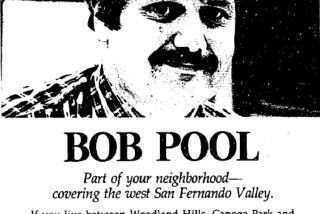Op-Ed: Tom Wolfe, the consummate New Yorker, found his subject and voice in California
- Share via
Although he was a Depression-era son of the South, Tom Wolfe was a consummate New Yorker. He lived there his entire adult life, and could often be seen walking on the Upper East Side in ice cream suits, an occasional gilt-tipped walking cane glinting in the sun. He was the city’s most recognizable flaneur.
Wolfe, who died this week at 88, was an atypical New Yorker in one important respect: He loved California. Or rather, he was enamored of the energies to be found here during the post-war era and the cultural movements that were upending the “statusphere” that was Wolfe’s idee fixe for his entire career.
When I was spending time in the early aughts with Wolfe for a book that I wrote on New Journalism, he had fond reminiscences about his California sojourns, including a few somewhat discomfiting nights with his friend Hunter S. Thompson. Wolfe embraced the dynamism and creative spirit of the region, and still felt its effects decades after he’d done his seminal reportage from the state.
As a journalist in the early 1960s, Wolfe’s profile subjects were West Coast figures: music producer Phil Spector, exotic dancer Carol Doda, “The Pump House Gang” surfers of La Jolla. Even “The Right Stuff,” his 1979 book about the Mercury space program, was largely centered on Edwards Air Force Base in Kern County. New York had its Astors and Rockefellers, but Wolfe instinctively knew that California was emerging as the breeding ground for the second half of the 20th century. In his articles and books, Wolfe explained California to the rest of us. He was the first significant New York writer to take the state seriously.
Wolfe took the measure of New York as a young reporter at the New York Herald Tribune and realized that everything novel he observed there was just a facsimile of the real changes taking place on the West Coast. While covering the 1963 New York Auto Show for the newspaper, Wolfe gravitated to the tricked-out, pinstriped custom cars created by L.A. natives Ed “Big Daddy” Roth, Dale Alexander and George Barris. He compared Roth’s custom cars to the enigmatic statues of Easter Island: “Suddenly you come upon the astonishing objects, and then you have to figure out how they got there and why they’re there.” Wolfe sold Esquire on the idea of a much larger article, and flew to Los Angeles to observe “Kustom Kulture” firsthand. It became the anchor piece for his essay collection, “The Kandy-Kolored Tangerine-Flake Streamline Baby.”
In L.A., Wolfe had stumbled onto a new modality of American life.
In L.A., Wolfe had stumbled onto a new modality of American life, a revved-up culture that was fed by post-war prosperity and a ritualized formalism that wasn’t beholden to the past — in short, the anti-New York. As Wolfe drove around Los Angeles, he was taken in by the city’s architecture, “shaped not like rectangles but like trapezoids, from the way the roofs slant up from the back and plate-glass fronts slant out as if they’re going to pitch forward on the sidewalk and throw up.” This was meant as a compliment. Wolfe saw the future in L.A.; to the largely right-wing, East Coast readership of the Herald Tribune, Wolfe’s reporting was heresy.
Even Wolfe’s technicolor prose style was shaped by his visits to L.A. in the 1960s. “When I started writing in what was known as my style, I was trying to capture the newness and excitement of the West Coast,” Wolfe told me in 2004.
Less than a year after Wolfe introduced custom cars to a national audience, he was anonymously sent a cache of letters by Ken Kesey. The author of “One Flew Over The Cuckoo’s Nest,” Kesey had jumped bail on a drug charge and was living in exile in Mexico. Down the rabbit hole went Wolfe into Kesey’s communal experiment with his followers the Merry Pranksters, spending weeks at the group’s La Honda compound in San Mateo.
What emerged was “The Electric Kool-Aid Acid Test,” which is both the definitive report on the San Francisco counterculture and a cherished literary artifact of the era. The book reads at times like an acid trip, as Wolfe introduced his daring prose style that carried echoes of Burroughs and Kerouac: “The sweet wheatfields and dairy lands of America would be sailing by beauty rural green and curving, and Sandy is watching the serene beauty of it … and then he happens to look into the big rear-view mirror outside the bus and — the fields are — in flames ::::::: curve and curdle straight up in hideous orange flames.”
As a satirist, Wolfe could be merciless. But that wasn’t the case with his dispatches from California. Wolfe’s tenderness and affection for the state’s endlessly renewable culture was palpable, both in conversation and in his work. In Los Angeles and other points west, Wolfe the social critic turned into an advocate.
Marc Weingarten is the author of “The Gang That Wouldn’t Write Straight: Wolfe, Thompson, Didion, Capote, and the New Journalism Revolution.”
Follow the Opinion section on Twitter @latimesopinionand Facebook
More to Read
A cure for the common opinion
Get thought-provoking perspectives with our weekly newsletter.
You may occasionally receive promotional content from the Los Angeles Times.










